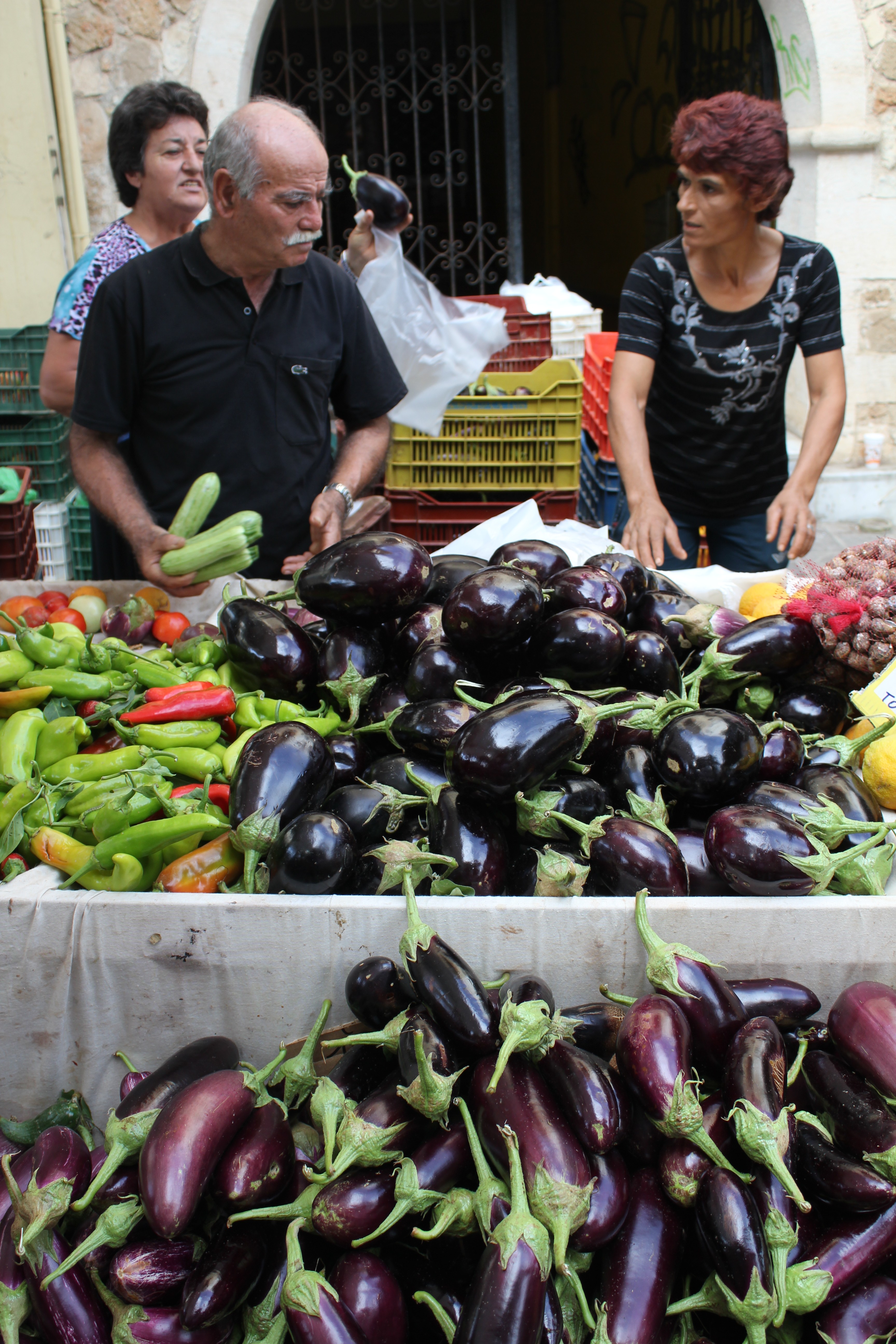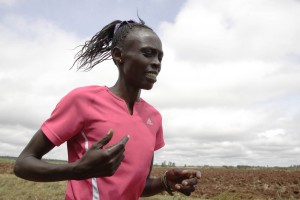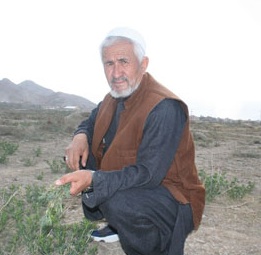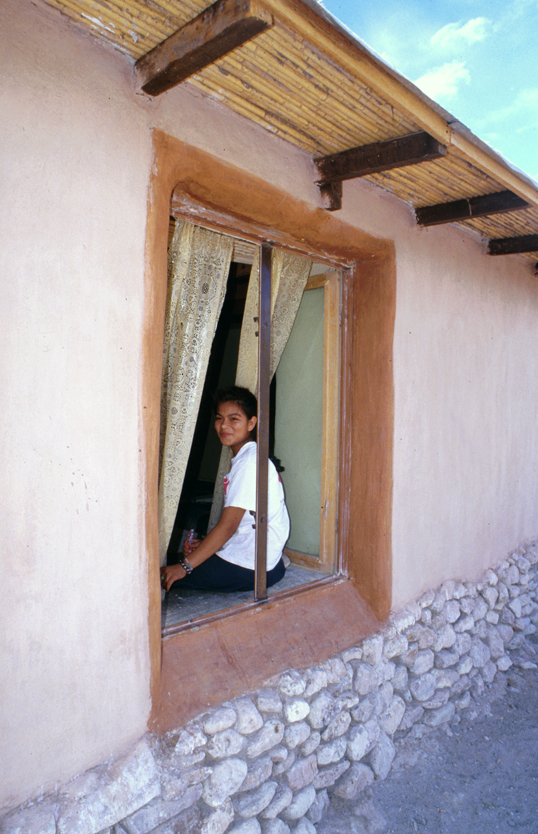Talk to Ghoste. That’s what everyone says. There are three shamans here among the nomadic reindeer herders of northern Mongolia. Or maybe six, depending whom you believe. But Ghoste is the real deal, the most powerful. They say you should talk to Ghoste, and then in the same breath, they say “but Ghoste doesn’t like to talk.”
Soyun is the oldest shaman, at 100. She’s a tiny woman, ancient, with bad knees. She struggles in her oortz, or teepee, to move between her sleeping platform and the kettle of salty milk-tea on the stove. When she steps outside, which isn’t often, she walks with the aid of two crooked sticks.
But they say that when Soyun performs her full shamanic ritual, those long nights, when she pounds the drum until the trance begins and the spirits – the ongots – enter her body, they say then she leaps and dances like a child.
Her drum is kept behind a curtain, in the place of honor opposite the door of the tent. She will not show it to a visitor. In fact, she is tired of all the questions. Talk to Ghoste, she says, talk to Ghoste.
Soyun was born across the border in Tuva, which is part of Siberia, and though the children now all speak Mongolian, Soyun still prefers the Tuvan language. During Mongolia’s communist period, her own daughter, Tsend, briefly made a living in the capital city of Ulaanbaatar, as a singer of Tuvan folk songs.
Tsend is about seventy now, and nearly blind. She has long returned to the taiga, high in the mountains where the reindeer herders live. Tsend, like her mother and her grandmother before that, is a shaman.
One bright and frigid morning, Tsend came out of her oortz, in her long green tunic and bare feet, to welcome some visitors. It had snowed the night before, and the visitors, having just ridden over a high mountain saddle, were swathed in gloves and wool hats and layers of synthetics. Tsend laughed about the cold. Her face is permanently etched with a squint and a smile. Bare feet, she said, are good for your health.
A shaman is a conduit to the spirit world. Shamanism is among humanity’s oldest religions. Not everyone can become a shaman, and Tsend’s story is typical. She was seven years old, when she became ill, falling to the ground with seizures. Her grandmother performed a shaman ceremony for her, dressing Tsend in her own costume. After that, Tsend developed the ability. Now her grandmother, Urel, is Tsend’s most important spirit.
To go to the spirits, the shaman needs some kind of transportation. Tsend sometimes travels by playing the mouth harp, but that, she says, can take her only so far. The most powerful transportation is the drum. A drum is like a horse. It can take you anywhere.
She does her ritual only once each season, or when someone comes to her with an illness or some other problem. When that happens, a shaman cannot refuse. Tsend agrees to play her mouth harp, but says it is not the right phase of the moon to show the drum.
Only about 200 nomadic reindeer herders remain in northern Mongolia. Geographically, they are divided into two distinct groups, known as the East and West Taiga. Tsend lives in the East; her mother and Ghoste in the West. She is happy to hear that her mother is well. Of Ghoste, she says, “he’s very strong.”
Ghoste is a striking man, about 50, with a broad face and high cheekbones. His eyes contain a glint of mischief, but also something a little frightening. He lives a little apart, higher up the mountain than the other reindeer herders. “Probably people think, because I live all alone in the wilderness,” he says, “that I am a wild man.” But he explains that this way is better for the reindeer. Later, he will say privately that it also helps him avoid the curiosity of outsiders. For several days, he avoids visitors. Eventually, though, he agrees to talk.
His tent is barer than most of the others. Reindeer skins and old pieces of canvas cover the floor. Tea is poured and a bowl of reindeer cheese offered around. A basin of bones and meat bubbles on the stove. Ghoste smokes constantly, rolling his cigarettes in pieces of torn newspaper.
“It is not easy being a shaman,” he says. A shaman receives many people who are struggling with sickness. “I cannot refuse. If I do, the spirits get weaker.” Ghoste says he has a responsibility for the people in the community, people who come and ask for help and believe with their hearts. If they believe, it will work for them.
He says the shaman’s job is to help people who have lost their hemur, or good fortune. The shaman can call it back for them. “I can’t cheat anyone or it would harm my family,” he says. “That is what happened in my life.” Ghoste is divorced. His son is dead.
“Once someone who was becoming unconscious came to me for help. I helped them, but they didn’t give me any offerings. That was bad for me, being the mediator in between. That’s why my son died.”
There are things Ghoste will not talk about: the ritual, his spirits. And, of course, he cannot show the drum. “This is not play,” he says. “Some people treat it like theater.”
It is customary and polite to give a gift to a person who has shown hospitality. So, the interview concluded, a few small things are produced, including a bottle of vodka. The translator leaves. The visitor goes outside to stretch, and then, a few minutes later, ducks back from the bright day into the dim tent, to say goodbye.
But instead, Ghoste motions him to return. Ghoste pats the ground in front of the green curtain. The visitor sits. In silence, the drum is produced. The shaman costume is unpacked: bundle after bundle of cloth strips, a feathered headdress, solid iron bells or clappers that hang across his shoulder blades. The skin drum is round, large, open on one side. Ghoste grins, and plays it ever so softly, like a heartbeat: thump thump, thump thump.
– Allan Coukell
Thanks to translators Binderiya Dondov, Badamtsetseg Tsedennyam, and Hosbayar Enkhtaivan (translators); Professor Gurbadar Purvee (Mongol Business Institute), Daniel Plumley (Totem Peoples Project), Judith Hangartner (Institute for Ethnology, University of Berne), and Nansalmaa Myagmar (Mongolian State Veterinary Laboratory).




























 Ismael “Babu” Hussein works as an assistant in one of Bangladesh’s shipbreaking yards, where armies of laborers dismantle old vessels the way ants devour a carcass. The work is perilous, the bosses abusive, the hours exhausting.
Ismael “Babu” Hussein works as an assistant in one of Bangladesh’s shipbreaking yards, where armies of laborers dismantle old vessels the way ants devour a carcass. The work is perilous, the bosses abusive, the hours exhausting. Brandon Davies’ life is all about risk.
Brandon Davies’ life is all about risk. For Mexican women of a certain age, finding decent work can be nearly impossible. Vicki Ponce was in her 50s, selling tamales, grateful for the money her daughter sent home from the U.S.
For Mexican women of a certain age, finding decent work can be nearly impossible. Vicki Ponce was in her 50s, selling tamales, grateful for the money her daughter sent home from the U.S. For most Afghan refugees, fleeing the war-torn country is a once-in-a-lifetime experience. For Alidad, it’s a job.
For most Afghan refugees, fleeing the war-torn country is a once-in-a-lifetime experience. For Alidad, it’s a job. If you’re a Korean man who wants to marry a Vietnamese woman, Hang Nga is your go-to gal.
If you’re a Korean man who wants to marry a Vietnamese woman, Hang Nga is your go-to gal. As a performer with The Great Moscow State Circus, Svitlana Svystun spends ten months a year traveling from fairground to fairground around the United Kingdom. Her coworkers include a human cannonball, a crossbow artist, and a crew of Hungarian roustabouts.
As a performer with The Great Moscow State Circus, Svitlana Svystun spends ten months a year traveling from fairground to fairground around the United Kingdom. Her coworkers include a human cannonball, a crossbow artist, and a crew of Hungarian roustabouts. In the mid-1990s, journalists and human rights groups began to uncover a web of slave labor linked to some of Brazil’s biggest export industries: cattle, soy, sugar cane, and pig iron used in making steel for automobiles.
In the mid-1990s, journalists and human rights groups began to uncover a web of slave labor linked to some of Brazil’s biggest export industries: cattle, soy, sugar cane, and pig iron used in making steel for automobiles. Your cell phone or laptop wouldn’t work without a mineral called coltan. The Democratic Republic of Congo has about 80 percent of the world’s coltan reserves, and that has spawned a corrupt and violent industry. Military factions vie for control of the mines, earning millions of dollars while the miners themselves barely scrape by.
Your cell phone or laptop wouldn’t work without a mineral called coltan. The Democratic Republic of Congo has about 80 percent of the world’s coltan reserves, and that has spawned a corrupt and violent industry. Military factions vie for control of the mines, earning millions of dollars while the miners themselves barely scrape by. Agus Laodi could barely feed his family with his earnings as a cocoa farmer. So eight years ago, with his wife’s blessing, he left his Indonesian village to seek his fortune on an island in the Strait of Malacca.
Agus Laodi could barely feed his family with his earnings as a cocoa farmer. So eight years ago, with his wife’s blessing, he left his Indonesian village to seek his fortune on an island in the Strait of Malacca. There’s a huge amount of human effort buried in almost everything around us. You just need to know where to look.
There’s a huge amount of human effort buried in almost everything around us. You just need to know where to look. Samanta moved to Baku, the capital of Azerbaijan, for the same reason that thousands of other foreigners did: the oil boom.
Samanta moved to Baku, the capital of Azerbaijan, for the same reason that thousands of other foreigners did: the oil boom. Whyman Richards says he’ll give anything a try.
Whyman Richards says he’ll give anything a try. Mohmen left his village at 13 and quickly found work stacking animal skins in one of Karachi’s many tanneries. He wasn’t allowed to stand by the window when the fumes overtook him. Now, at 17, he’s still doing the same job.
Mohmen left his village at 13 and quickly found work stacking animal skins in one of Karachi’s many tanneries. He wasn’t allowed to stand by the window when the fumes overtook him. Now, at 17, he’s still doing the same job. Nigeria produces more movies per year than any other country but India and the United States. Since the 1990s, “Nollywood” videos have been an entertainment staple – and a source of pride – for Africans everywhere.
Nigeria produces more movies per year than any other country but India and the United States. Since the 1990s, “Nollywood” videos have been an entertainment staple – and a source of pride – for Africans everywhere. For thousands of years, traders have plied the waters of the Persian Gulf, braving pirates, warships, and sudden storms in wooden cargo boats called dhows.
For thousands of years, traders have plied the waters of the Persian Gulf, braving pirates, warships, and sudden storms in wooden cargo boats called dhows. About one-fourth of the people who live in Saudi Arabia are foreign workers. Many come from Sunni Muslim countries such as Indonesia, Pakistan, or Bangladesh. But others are Christians, Buddhists, Hindus, and minority Shiites.
About one-fourth of the people who live in Saudi Arabia are foreign workers. Many come from Sunni Muslim countries such as Indonesia, Pakistan, or Bangladesh. But others are Christians, Buddhists, Hindus, and minority Shiites. The New York Times called Chloé Doutre-Roussel a “goddess.” International chocolate guru Martin Christy compares her to Joan of Arc.
The New York Times called Chloé Doutre-Roussel a “goddess.” International chocolate guru Martin Christy compares her to Joan of Arc. Remember Hercules, the hero from Greek mythology? He’s famous for the twelve labors he was forced to perform by one of his rivals. One of the toughest was to get rid of 30 years worth of manure left by a herd of royal cattle.
Remember Hercules, the hero from Greek mythology? He’s famous for the twelve labors he was forced to perform by one of his rivals. One of the toughest was to get rid of 30 years worth of manure left by a herd of royal cattle. The garment industry is a place where dreams are more often shattered than fulfilled. The margins are low, the work is exacting, and the competition is brutal. It’s hard to imagine why anyone would actually choose to get into the business.
The garment industry is a place where dreams are more often shattered than fulfilled. The margins are low, the work is exacting, and the competition is brutal. It’s hard to imagine why anyone would actually choose to get into the business. More than one-fifth of all NBA players are from outside the United States, including some of the league’s biggest stars. Most of these foreign players have been on the league’s radar since they were barely old enough to dunk. That’s thanks to a global army of basketball gumshoes, scouring the planet for talent.
More than one-fifth of all NBA players are from outside the United States, including some of the league’s biggest stars. Most of these foreign players have been on the league’s radar since they were barely old enough to dunk. That’s thanks to a global army of basketball gumshoes, scouring the planet for talent. Walk into your local chain restaurant and you can get a lobster tail for around 15 bucks. Ever wonder where the lobster comes from, or why it’s so cheap?
Walk into your local chain restaurant and you can get a lobster tail for around 15 bucks. Ever wonder where the lobster comes from, or why it’s so cheap? Pam Pardy and Blair Ghent left good jobs in Toronto to return home to rural Newfoundland. They thought the quality of life would be better there for their son Brody.
Pam Pardy and Blair Ghent left good jobs in Toronto to return home to rural Newfoundland. They thought the quality of life would be better there for their son Brody. Every weekday, Mr. Wang says goodbye to his daughter and his beloved pigeons in an old-fashioned Beijing neighborhood, mounts his bicycle and ventures into the chaos of the city.
Every weekday, Mr. Wang says goodbye to his daughter and his beloved pigeons in an old-fashioned Beijing neighborhood, mounts his bicycle and ventures into the chaos of the city. Diana Dimova says she’s never so moved as when she sings the ancient mountain music of her native Bulgaria. The music, distinguished by its haunting harmonies, was briefly popular in western Europe, and still enjoys a small but loyal audience.
Diana Dimova says she’s never so moved as when she sings the ancient mountain music of her native Bulgaria. The music, distinguished by its haunting harmonies, was briefly popular in western Europe, and still enjoys a small but loyal audience.

 Long after the fighting ended in Kosovo in 1999, the people of the region are still struggling to free themselves from the legacy of war.
Long after the fighting ended in Kosovo in 1999, the people of the region are still struggling to free themselves from the legacy of war. The term “ecovillage” evokes pastoral visions of earthen homes and glistening solar panels. But in cosmopolitan Los Angeles, the idea of ecological alternative living gets stretched to include an urban slum neighborhood and a Mexican-American barrio, complete with electric low-riders and solar-powered rap recording studios.
The term “ecovillage” evokes pastoral visions of earthen homes and glistening solar panels. But in cosmopolitan Los Angeles, the idea of ecological alternative living gets stretched to include an urban slum neighborhood and a Mexican-American barrio, complete with electric low-riders and solar-powered rap recording studios. A story of the birth of a sustainable housing movement in Sonora, in northern Mexico.
A story of the birth of a sustainable housing movement in Sonora, in northern Mexico. The birth of a sustainable housing movement in Sonora, in northern Mexico. A
The birth of a sustainable housing movement in Sonora, in northern Mexico. A 